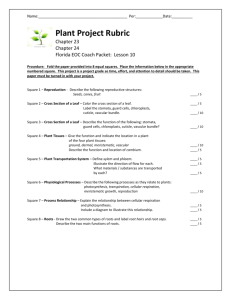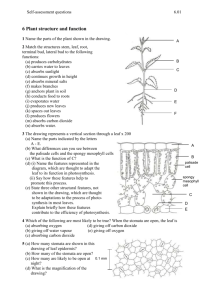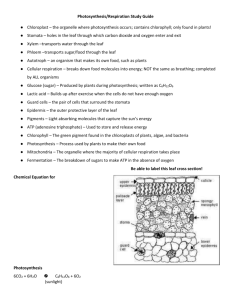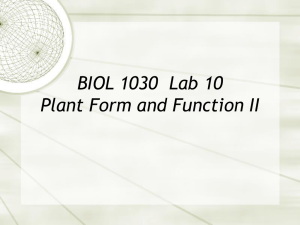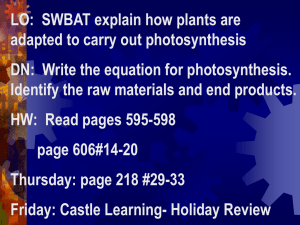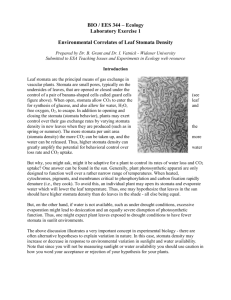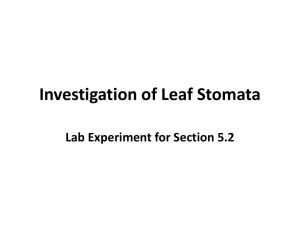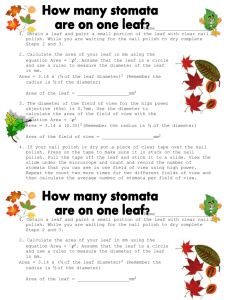Monocot vs. Dicot
advertisement
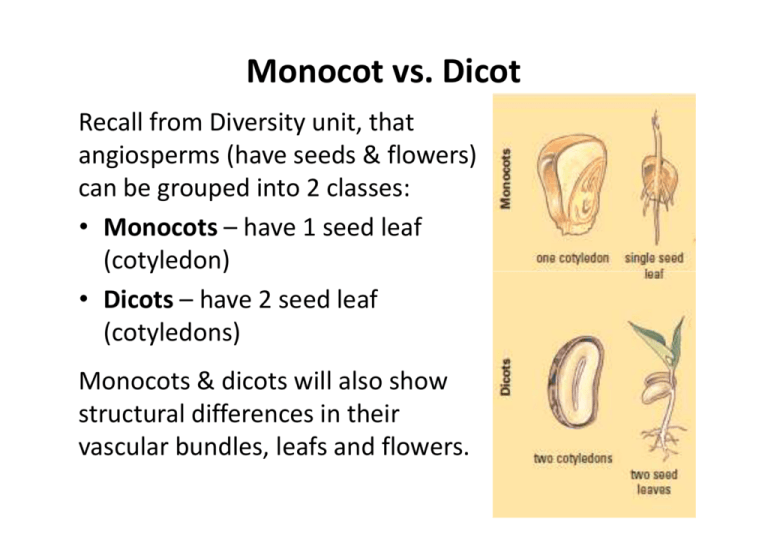
Monocot vs. Dicot Recall from Diversity unit, that angiosperms (have seeds & flowers) can be grouped into 2 classes: • Monocots – have 1 seed leaf (cotyledon) • Dicots – have 2 seed leaf (cotyledons) Monocots & dicots will also show structural differences in their vascular bundles, leafs and flowers. Vascular Bundles Differences in the vascular bundles arrangement: vs. Dicot Monocot Leaves Structure of leaves vary – an adaptation to the biotic factors (such as competitors, predators) and abiotic factors (such as temperature, soil conditions, etc) Leaves must balance the need of maximizing photosynthesis with the problem of drying out. Structure of leaves Blade – flat main body of leaves Petiole – leaf stalk Node – points where leaves are positioned on stem Internode – distance between nodes Monocot vs. Dicot Structure of leaves Notice the difference in vascular tissue branching (vein patterns) of the leaves: Monocot Parallel venation vs. Dicot Net venation Structure of leaves Can also differentiate between: Simple leaf vs. single, undivided blade Compound leaf two or more divided blades Components of leaves Chloroplast • Double-membrane organelle • Inside chloroplast are flat, disc-like structures called thylakoids. • Chlorophyll is green-pigment found in membranes of thylakoids. • Stacks of thylakoids is called grana and act as solar collector. Components of leaves Tiny pores on the leaves (called stomata) allows for: • diffusion of CO2 into the leaves • diffusion of O2 out of the leaves during photosynthesis process. Q: Most plants have stomata on the lower surface of the leaf. Why? 1. Reduce water loss 2. Allows packing of more cells that can do photosynthesis on the upper layer 3. Reduce chances of entry of foreign organisms Components of leaves Stomata also allow water vapour to escape from leaf transpiration. Opening & closing is controlled by a pair of chloroplastcontaining guard cells which will: bend outward (to open) OR collapse inward (to close). Q: How does the plant know when to open /close their stomata? A: Stomata need to open during the day (sunlight) to do photosynthesis. However, plant can then dry out quickly. Guard cells can detect water level in the plant to control opening/closing of stomata. Lots of water guard cells expand stomata open Little water guard cells collapse stomata close Guard cells also respond to CO2 level, light level, temperature, abscisic acid concentration to control opening/closing of stomata. Simple diffusion of gases (from area of HIGH to LOW concentration): • During photosynthesis, CO2 is being used up, so its level in plant is low compared to atmosphere. Thus CO2 diffuse in through the stomata. • During photosynthesis, O2 is being produced, so its level in plant is HIGH compared to atmosphere. Thus O2 diffuse out of the stomata. Palisade layer: a layer of tall, closely packed parenchyma cells containing chloroplasts, just below the upper surface of leaf. Spongy mesophyll: a region of loosely packed parenchyma cells containing chloroplasts, in the middle of a leaf. Loose packing allows rapid diffusion of CO2 into and O2 out of cells. Both are part of ground tissue system. Adaptation to abiotic factors Leaf structure is an adaptation to their environment: Broad leaves – good for those in shaded area, appear early spring Thin, long needles in conifers: Small surface area with waxy cuticle prevents water loss during winter time Adaptation to abiotic factors Cacti spines – modified leaves. Very few stomata, small surface area. Photosynthesis on the stems instead. Able to survive in area of low precipitation. Xerophyte – plants that survive in areas with little moisture Hydrophyte – plants living on/in water Mesophyte – plants living in areas with moderate moisture Adaptation to biotic factors To prevent being eaten by herbivores, some plants develop: •Tough, hairy, prickly or bitter leaves •Toxins (ex: milkweed, nicotine in tobacco leaves) However herbivores can adapt as well by having tough mouth tissues, low tasting ability, immunity to toxins (ex: monarch butterfly can eat milkweed). Other leaf adaptations Carniverous plants – thrive better with animal proteins Indian pipe – white because no chlorophyll. Not able to photosynthesize. Saprophytes – gets nutrients from decaying materials in soil.
